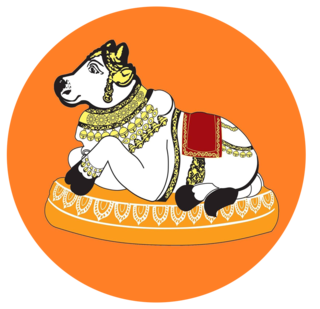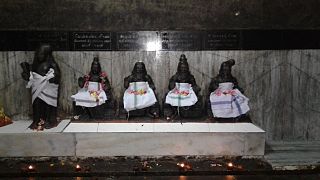Siddhānta, a Sanskrit term denoting the established and accepted view of any particular school within Indian philosophy. Literally "settled opinion or doctrine, dogma, axiom, received or admitted truth; any fixed or established or canonical text-book on any subject".

Niyama literally means positive duties or observances. In Indian traditions, particularly Yoga, niyamas and its complement, Yamas, are recommended activities and habits for healthy living, spiritual enlightenment and liberated state of existence. It has multiple meanings depending on context in Hinduism. In Buddhism, the term extends to the determinations of nature, as in the Buddhist niyama dhammas.

Shaiva siddhanta,(IAST: Śaiva siddhānta), provides the normative rites, cosmology and theological categories of Agamic and Vedic Shaivam combined. Being a dualistic philosophy, the goal of Shaiva Siddhanta is to become an enlightened soul through Lord Shiva's Grace.

Mangala is the name for Mars, the red planet, in Hindu texts. Also known as Lohit, he is born from Shiva's sweat or blood drop. also he is the god of war, celibate and sometimes linked to god Karttikeya (Skanda). His origins vary with different mythological texts; in some, he is the son of Bhumi, the Earth Goddess and Vishnu, born when he raised her from the depths of water during the time of the Varaha avatar.

Siddha is a term that is used widely in Indian religions and culture. It means "one who is accomplished". It refers to perfected masters who have achieved a high degree of physical as well as spiritual perfection or enlightenment. In Jainism, the term is used to refer the liberated souls. Siddha may also refer to one who has attained a siddhi, paranormal capabilities.

The Tirumantiram or Thirumantiram is a Tamil poetic work written in the 1000 BC by Thirumular and is the tenth of the twelve volumes of the Tirumurai, the key texts of Shaiva Siddhanta and the first known Tamil work to use the term. Tirumantiram's literal meaning is "Holy incantation". The Tirumantiram is the earliest known exposition of the Shaiva Agamas in Tamil. It consists of over three thousand verses dealing with various aspects of spirituality, ethics and praise of Shiva. But it is more spiritual than religious and one can see the difference between Vedanta and Siddhanta from Tirumular's interpretation of the Mahavakyas. According to historian Venkatraman, the work covers almost every feature of the siddhar of the Tamils. According to another historian, Madhavan, the work stresses on the fundamentals of Siddha medicine and its healing powers. It deals with a wide array of subjects including astronomy and physical culture.

Vārāhamihira, also called Vārāha or Mihira, was a Hindu polymath who lived in Ujjain. He was born in the Avanti region, roughly corresponding to modern-day Malwa, to Adityadasa, who was himself an astronomer. According to one of his own works, he was educated at Kapitthaka. The Indian tradition believes him to be one of the "Nine Jewels" (Navaratnas) of the court of legendary ruler Yashodharman Vikramaditya of Malwa. However, this claim appears for the first time in a much later text and scholars consider this claim to be doubtful because neither Vihiramihira and Vikramaditya lived in the same century nor did Varahamihira live in the same century as some of the other names in the "nine jewels" list such as the much older Kalidasa.
Nandinatha Sampradaya is a denomination of Shaivism sect of Hinduism that places great importance on the practice of yoga. It is related to the broader Nath Sampradaya. Living preceptor and 163rd head of the Nandinatha Sampradaya's Kailasa Parampara is Bodhinatha Veylanswami. It is most popular among Sri lankan and south Indian hindu.

The Surya Siddhanta is the name of a Sanskrit treatise in Indian astronomy from the late 4th-century or early 5th-century CE. The text survives in several versions, was cited and extensively quoted in a 6th-century CE text by Varahamihira, was likely revised for several centuries under the same title. It has fourteen chapters. A 12th-century manuscript of the text was translated into English by Burgess in 1860.
The phrase siddha yoga can refer to:

Siddha medicine is a system of traditional medicine originating in ancient Tamilakam in South India and Sri Lanka.

Bapudeva Sastri (1821–1900) was an Indian scholar in Sanskrit and mathematics.
The Pauliśa Siddhānta refers to multiple Indian astronomical treatises, at least one of which is based on a Western source. "Siddhānta" literally means "doctrine" or "tradition".
The Romaka Siddhanta is one of the five siddhantas mentioned in Varaha Mihira's Panchasidhantika which is an Indian astronomical treatise. Romaka Siddhanta is based on the astronomical learning of Byzantine Rome. "Siddhanta" literally means "Doctrine" or "Tradition."
National Institute of Siddha is an institute for study and research of Siddha medicine. It was established in 2005 at Tambaram, Chennai, India. It is one of the eight national institutes established across nation, for training and research in "Indian Systems of Medicine and Homeopathy education", by Department of AYUSH, Government of India,

Swayamsiddha is a 2010 Oriya film directed by Sudhanshu Sahu with a screenplay and dialogue by Dilip Choudhury, produced by Prabhat Ranjan Mallik, and starring Siddhanta Mahapatra, Sunil Kumar, and Yukta. The film focuses on the implications for the young mass adopting to Maoist insurgency and their sustained alienation from the mainstream as a result. Geo-strategic importance of changing the minds of young people adopting terrorism through love and affection. The film traces the crisis from social trauma to unfair state system encouraging Mao-Naxal insurgency in Orissa.
Siddhānta Śiromani is the major treatise of Indian mathematician Bhāskara II. He wrote the Siddhānta Śiromani in 1150 when he was 36 years old. The work is composed in Sanskrit Language in 1450 verses.
Yogi Nath is a related group of monks which emerged around the 13th-century. They are sometimes called Jogi or simply Yogi, and are known for a variety of siddha yoga practices. Their tradition is known as Nath Sampradaya.

Meykandar, also known as Meykanda Devar, was a 13th-century philosopher and theologian who contributed to the Shaiva Siddhanta school Shaivism. His literary work known as Śiva Jñāna Bodham on Shaiva Siddhanta has enjoyed great vogue and prestige among Tamilians compared to other well-known Hindu philosophies such as Advaita of Adi Shankara and Vishistadvaita of Ramanuja.










